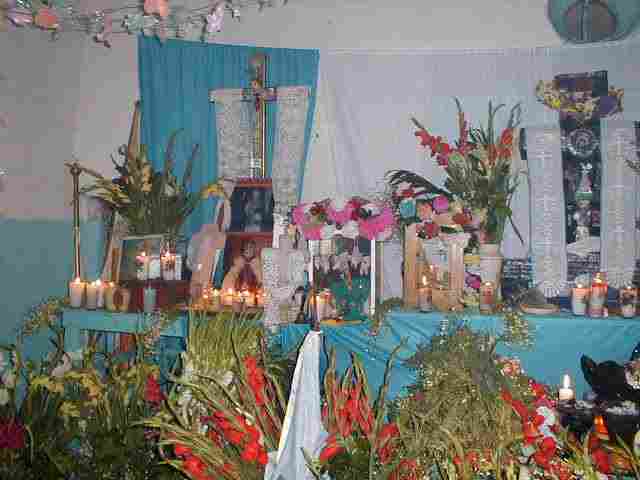San Miguel de Allende, Gto México
THE SACRED CROSS OF CALDERON
 |
 |
 |
BY: Phyllis Correa
During the month of May, there are celebrations for all of the crosses in the region. The round of fiestas begins in Calderon (also called Puerto de Bárbaros) and ends at the beginning of June in Valle del Maiz. Elements of the celebrations which are part of the cult of the Sacred Cross, the apostle Saint James, and the ancestors, include music with instruments made out of armadillo shells, melodies and hymns which call on the spirits and the four winds, blessings or cleansings by special lay practioners to bring good luck and protect from evil and envy, nightlong vigils, and trances to communicate with the spirits. There are traditional dances, fireworks, and food sharing as well.
It is believed that this cross was outlined in the rocks of the arroyo of los Frailes (remember that one-lane bridge just before the turnoff to the Allende dam on the way to Celaya) when the natives of this area were conquered by the Spaniards together with native Otomí (Hñahñu in their own language) warriors who accompanied them. The Santa Cruz is carved out of stone and about one and half meters high. It is a burnished chocolate brown color with paintings of catholic symbols representing the passion and death of Christ.
Because the symbol of the cross is common to both pre-Columbian and Spanish culture, it was accepted by the conquered peoples although at first they would not worship wooden crosses but only stone ones like that at Calderon. In Hñahñu culture, the cross symbolized the four cardinal points which corresponded to the four elements of their philosophy, theology and cosmology, water, earth, fire, and air. The cross represented a dual conceptualization of the universe and center of the world which was formed by the line of God, from east to west, and traversed by the line of man running from south to north (1). Embedded in the center of the cross at the axis is a head of Christ carved out of wood. Usually the cross is dressed with cloth leaving only the extremities and the head of Christ showing.
These celebrations to the Sacred Cross are part of the process of syncretism (a combination of traits from indigenous religion and Catholicism) which was one of the responses to the forced domination and acculturation of the Conquest. These traditions are preserved within the rural population and urban sectors in part because participants can obtain certain privileges, prestige, authority, and maintain important personal relationships. At the same time, they include important religious and cultural content with its own vitality retaining a Hñahñu configuration despite 450 years of domination by Spanish culture (2).
1. Luis Ugalde Monroy. La Cruz en la Cultura Hñahñu. "Noticias: Diario de Mañana. Querétaro." 28/8/92.
2. Gabriel Moedano. Los hermanos de la Santa Cuenta: un culto de crisis de origen chichimeca. XII Mesa Redonda de Antropología. 1972.
|
|
|